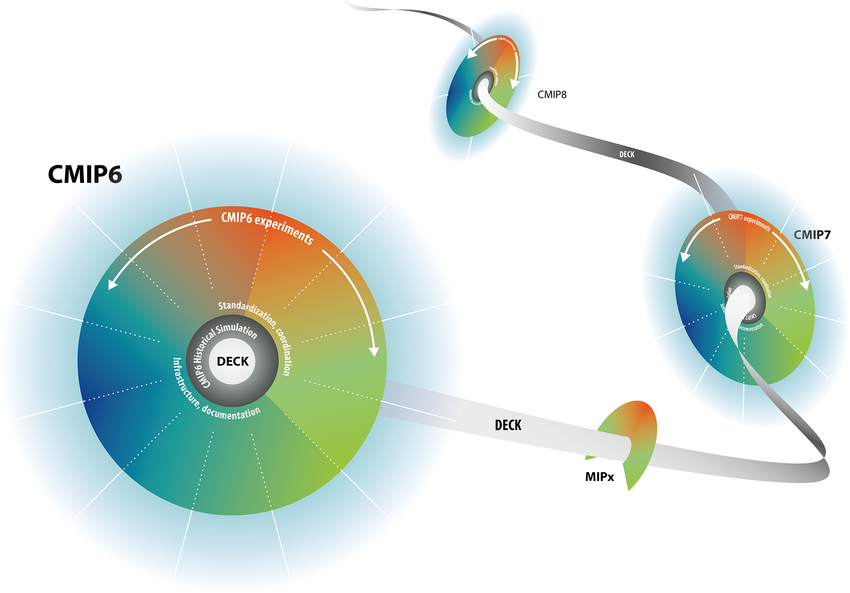The Coupled Model Intercomparison Project (CMIP) has become, since its establishment in 1995, one of the foundational elements of climate science. And to address the changing needs of users and take stock of the experiences with previous phases of the project, the CMIP Panel and the Working Group on Couple Modelling (WGCM) Infrastructure Panel (WIP) have launched a “CMIP Community next steps survey”, with a deadline of 14 March 2022. The survey aims to gauge community sentiment, with a particular interest in responses from users of the data and the academic and policy-making world. The survey is essential, as the survey will be the foundation of deciding the future of CMIP. If you are involved in CMIP experiments or use CMIP data, this is your opportunity to tell us what should come next.
What is CMIP?
CMIP, under the leadership of the World Climate Research Programme (WCRP) Working Group on Coupled Modelling (WGCM), its Infrastructure Panel (WIP), and the CMIP Panel, brings together modelling centres from around the world. The aim is to benchmark, intercompare and improve state-of-the-art climate model simulations and future projections. The first set of standard CMIP experiments in CMIP involved comparing responses from a handful of climate models to an idealized forcing - a constant rate of increase using a CO2 increase of 1% per year. Since that time, the number of CMIP experiments has increased dramatically. The latest phase, CMIP6, is an extensive activity with more than 140 models from 52 institutions representing 26 countries. For the latest CMIP6 cycle alone, the volume of data downloaded has reached over 30 petabytes and will only continue to increase.
The new CMIP International Project Office
To provide robust support to CMIP and the increasing demand for climate information, WCRP has opened a new International Project Office dedicated to CMIP activities. Headed by the incoming director, Eleanor O’Rourke, the new office will enhance the effectiveness and efficiency of support for national and international assessments. It will coordinate discussions with scientific and user communities on extending standardization protocols, data policies, and model output and analysis quality-control. The new office is hosted alongside ESA’s Climate Office at its European Centre for Space Applications and Telecommunications (ECSAT) facility in the United Kingdom.
One of the first activities for this Project Office, in support of the CMIP and WIP Panels, will be the analysis of the “CMIP Community next steps survey”. Launched in January, the survey will aid the preparation for the next phase of CMIP. Specifically, the survey hopes to understand the positive aspects and challenges that modelling centres and CMIP data users faced with CMIP6 and how future CMIP phases are structured and delivered to meet expanding needs.
Jean-François Lamarque, Director of the National Center for Atmospheric Research’s Climate and Global Dynamics Laboratory in the USA, and Chair of the CMIP Panel, talks about the successes of CMIP and the importance of this survey for the future of CMIP.
Why can CMIP be considered a success?
CMIP has brought to the forefront the power of multi-model analysis, combined with the definition of simulation protocols to enable the meaningful comparison of model responses. In addition, the CMIP effort has focused on the harmonization of model output formats, all the way to naming conventions and units. This combination has enabled researchers across the globe to develop an understanding of the role of forcings, such as the increase of CO2 in the atmosphere, in driving climate change, while considering the inherent variability of the unforced system. Over the course of its phases, CMIP has developed from its original limited set of simulations and few modeling groups to a truly global effort, spanning the range of physical, biological, and chemical processes that are driving or responding to climate change. The generation of data over all its phases provides a wealth of data that continue to be mined for a better understanding of how climate has changed and how likely it is to change. And this has been a key aspect of many assessments, especially the IPCC Assessment Reports.
Why is the CMIP survey critical?
As in the case of CMIP5, the post-CMIP6 survey will provide a broad understanding of where the community of modeling groups and data users. Taking the pulse of all communities interested in CMIP will give us the information to decide what, when, and how the next phases of CMIP should be defined to optimize their usefulness.
What’s next for CMIP?
CMIP represents a huge investment of resources and people. And one has to ask the question of how to balance cutting-edge climate science with stakeholder and policyholder needs to best inform and plan for future climate change. The goal of the survey and the subsequent steps for CMIP will be to identify the best use of resources to answer the most pressing questions related to climate change and its impacts on the whole Earth System.

Image: Eyring, et al., 2015

